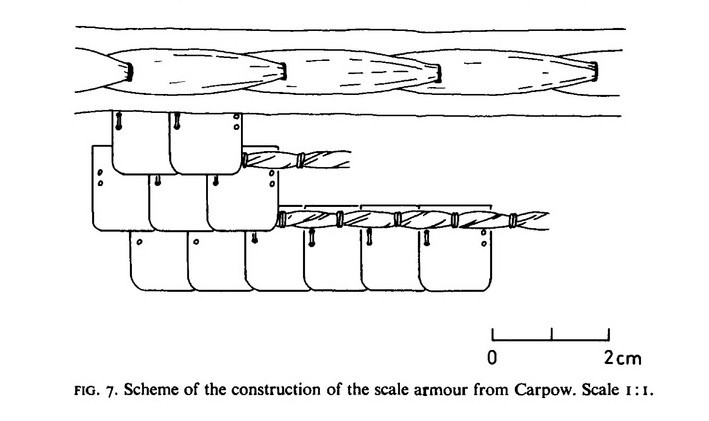I have been working on a scale armor and the scales feel very cumbersome. Am I doing something wrong or is scale armor just super cumbersome. [ Linked Image ]
Looks like the plates are a little too thick. Typical thickness of scales was around 0.5mm or even less. In any case, yes it is very cumbersome. Scale is the heaviest type of armour construction. Lamellar reduced the weight a little by getting rid of the need for a backing material.
| Dan Howard wrote: |
| Looks like the plates are a little too thick. Typical thickness of scales was around 0.5mm or even less. In any case, yes it is very cumbersome. Scale is the heaviest type of armour construction. Lamellar reduced the weight a little by getting rid of the need for a backing material. |
The scales should overlap horizontally, more than yours do. That will close up all those potential gaps. And unfortunately it will increase the number of scales you need, and the weight as well. So, yeah, .9mm is too thick!
Also remember that scales will cut their own stitching, just by the movement of being worn. So tie off your stitching thread at least every third scale (if not *every* scale!) so that you don't end up shedding whole rows.
Have fun!
Matthew
Also remember that scales will cut their own stitching, just by the movement of being worn. So tie off your stitching thread at least every third scale (if not *every* scale!) so that you don't end up shedding whole rows.
Have fun!
Matthew
Although it's not the only way to punch or sew scales, the Roman fragment from Carpow at least retained the original stitching and backing fabric, so might be useful.
 Attachment: 42.36 KB
Attachment: 42.36 KB


| Matthew Amt wrote: |
| The scales should overlap horizontally, more than yours do. That will close up all those potential gaps. And unfortunately it will increase the number of scales you need, and the weight as well. So, yeah, .9mm is too thick!
Also remember that scales will cut their own stitching, just by the movement of being worn. So tie off your stitching thread at least every third scale (if not *every* scale!) so that you don't end up shedding whole rows. Have fun! Matthew |
I have already made 126 0.9 mm scales which were way too labor intensive to abandon just because they're too thick, but I'll be sure to make the remaining scales out of thinner steel. Perhaps one batch of 0.7 mm and then 0.5 mm for the rest? I could put the thickest scales on the front upper torso and have the thinner scales further down and on the back like how chainmail sometimes becomes finer on the extremities?
Currently the scales are attached as close as possible horizontally without being joined together but I could change it so the outermost holes on each scale overlaps.
| Quote: |
| Although it's not the only way to punch or sew scales, the Roman fragment from Carpow at least retained the original stitching and backing fabric, so might be useful. |
Yes that looks like a good way to attach scales, having holes in more than just one horizontal row should keep them in place better and make it much less cumbersome methinks.
Just move the old 0.9mm scales to the chest area and use 0.5mm scales for the rest. If you want to tailor it like mail armour then you use smaller scales for expansion and contraction gussets or you adjust the degree of horizontal overlap between scales in those areas.
Page 1 of 1
You cannot post new topics in this forumYou cannot reply to topics in this forum
You cannot edit your posts in this forum
You cannot delete your posts in this forum
You cannot vote in polls in this forum
You cannot attach files in this forum
You can download files in this forum
All contents © Copyright 2003-2006 myArmoury.com — All rights reserved
Discussion forums powered by phpBB © The phpBB Group
Switch to the Full-featured Version of the forum
Discussion forums powered by phpBB © The phpBB Group
Switch to the Full-featured Version of the forum